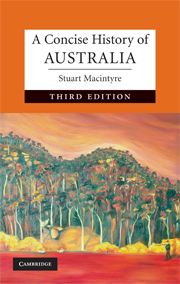Book contents
- Frontmatter
- Contents
- List of illustrations
- Acknowledgements
- Map 1.1 Australia: the main rivers, cities and towns
- 1 Beginnings
- 2 Newcomers, c. 1600–1792
- 3 Coercion, 1793–1821
- 4 Emancipation, 1822–1850
- 5 In thrall to progress, 1851–1888
- 6 National reconstruction, 1889–1913
- 7 Sacrifice, 1914–1945
- 8 Golden age, 1946–1974
- 9 Reinventing Australia, 1975–2008
- 10 What next?
- Sources of quotations
- Guide to further reading
- Index
2 - Newcomers, c. 1600–1792
- Frontmatter
- Contents
- List of illustrations
- Acknowledgements
- Map 1.1 Australia: the main rivers, cities and towns
- 1 Beginnings
- 2 Newcomers, c. 1600–1792
- 3 Coercion, 1793–1821
- 4 Emancipation, 1822–1850
- 5 In thrall to progress, 1851–1888
- 6 National reconstruction, 1889–1913
- 7 Sacrifice, 1914–1945
- 8 Golden age, 1946–1974
- 9 Reinventing Australia, 1975–2008
- 10 What next?
- Sources of quotations
- Guide to further reading
- Index
Summary
The stories of the Dreaming tell of beginnings that are both specific and general. They narrate particular events that occurred in particular places, but those events are not fixed chronologically since they span the past and the present to carry an enduring meaning. Archaeologists and prehistorians seek a different sort of precision, yet their hypotheses and conjectures can provide only broad approximations for the first human habitation in Australia. By contrast, the story of the second settlement is known in minute particularity. It consisted of 1066 people who had sailed in eleven vessels to New South Wales from the southern English naval town of Portsmouth, via Tenerife, Rio de Janeiro and Cape Town, on a marathon voyage of just over eight months; thirty-one died during the voyage. The survivors reached the north shore of Botany Bay on 18 January 1788, but landed 12 kilometres to the north in a cove of Port Jackson eight days later. On a space cleared in the wooded slope that is now central Sydney, the British flag was hoisted as the commander, Captain Arthur Phillip, took formal possession of the new colony.
We have his account of the voyage and settlement, as well as other published accounts, and the official instructions, dispatches, logs, journals, diaries and letters of those who accompanied him. We know the names of every person, their status and duties, the stores they brought with them and the livestock, plants and seeds, even the books, that they brought ashore to establish the colony.
- Type
- Chapter
- Information
- A Concise History of Australia , pp. 16 - 34Publisher: Cambridge University PressPrint publication year: 2009



